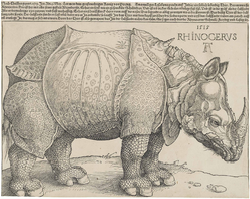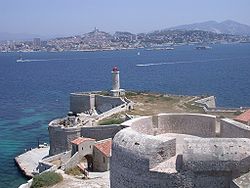Château d'If
The Château d'If [ ʃɑtoˈdif ] is a fortress and a former prison on the Île d'If , a rocky island about a nautical mile off the coast of Marseille . Today it is a tourist attraction .
history
The fortress
The French king Francis I made on his return from the victory at Marignano (1515) held in Marseille. To test the defensive capabilities of the city, he went to the Île d'If. He found that the city had no protection against invasion and ordered the construction of a fortress on the island. Since Marseilles, which fell to France in 1481, had been able to retain the privilege of defending itself from that time on, there was strong resistance against the fortress.
Eight years later, in 1524, Charles V's troops tried to besiege the still unfortified Marseille. The attack could be repulsed by King Mirandal's commissioner, but it became clear how important it was to fortify the access to the city. In the same year the first walls of the fortress were erected to protect the port entrance.
The fortress was built between 1524 and 1531. It dominated the approach to the port of Marseille, was supposed to protect the roadstead from any attack and secure the city's food supply from the sea.
The townspeople did not appreciate the new fortress and called it the "uninvited neighbor". Even when 200 soldiers and 22 artillery pieces were posted on the fortress, the people of Marseille did not stop protesting against them. For them it was a symbol of the central power of France on their territory. Despite resistance from the townspeople, the fortress was completed in July 1531.
Five years later it had military importance for the first time when Charles V had to give up his offensive because of the fortress in 1536 when he tried again to take Marseille.
The prison
The fortress was put into operation as a prison in the middle of the 16th century, a few years after its completion. The reason was the geographical location and the architecture. Breaking out seemed impossible.
1580 Knight Anselm was probably the first prisoner to be imprisoned. He was accused of conspiracy against the monarchy and was later strangled in his cell.
In the 17th century, the facility served as a place of accommodation for state prisoners. After the opponents of royal power, the cells particularly received Protestants who were incarcerated in the Château d'If after the revocation of the Edict of Nantes . For two centuries, around 3,500 Protestants were put behind bars at Château d'If, including Jean Serres and Elie Neau.
Even sons from a good family stayed involuntarily at the Château d'If after receiving a lettre de cachet (royal arrest or banishment warrant without a judicial judgment). This is what happened to Mirabeau , who was imprisoned in 1774 at the request of his father. Compared to the poor, he had a pleasant time, because he could rent a pistol , a reasonably furnished, spacious room on the first floor with windows and a fireplace. Penniless sat in windowless cells without the slightest comfort. In addition, Mirabeau knew how to appease the commanding officer and seduced the cook. Jean-Baptiste Chataud, captain of the Grand Saint-Antoine , which in 1720 spread the plague in Marseille, also “sat” in the Château d'If . The remains of General Kléber were brought here after his murder in Cairo .
120 people were imprisoned in the fortress after the uprising in June 1848. The inscription House of the Sovereign People above the former entrance gate to the courtyard dates from this time .
Republicans were also imprisoned here during the Second Empire .
architecture
The island is made of limestone and has an area of approximately 3 hectares.
The fortress itself has the main floor plan of a square with a side length of 28 m, flanked by 3 cylindrical towers ( rondelles ). Each tower has wide loopholes. The Saint Christophe tower (1) in the northwest is the tallest tower and monitors the open sea from a height of 22 m. The tower was built between 1524 and 1527; the associated residential tower ( donjon ) dates from 1529. The towers Saint Jaume (2) and Maugovert (3) are opposite in the northeast and southeast of the city. The towers are connected by a spacious terrace over a narrow, deep courtyard, onto which two floors extend - living area and kitchen on the ground floor, casemates on the first floor. The three towers combined a considerable firepower that made the Château d'If a mighty citadel. It consists of three levels.
In 1702 Sébastien Le Prestre de Vauban had a guard building built on the right in front of the exit of the fortress, the so-called Caserne Vauban .
The fortress became open to the public in 1890 and was placed under monument protection on July 7, 1926.
Memorabilia
The rhino

The island was first known when the first rhinoceros Europe has ever seen stopped here in 1516 .
The king of the Indian Kingdom of Gujarat in 1513 gave the King of Portugal Manuel I a rhinoceros . The Portuguese king wanted the animal to Pope Leo X on pay. The animal was shipped from Lisbon to Rome and made a stopover in Marseille on the Île d'If in 1516. The animal, previously unknown in Europe, aroused the curiosity of the townspeople, but Francis I also admired it on his return from the battle of Marignano on the island. The ship stayed off the island for a few weeks and then sailed on to Rome. On the way it got caught in a violent storm and crashed on the Ligurian coast north of La Spezia . The rhinoceros's body was washed ashore and the Pope only saw the animal stuffed .
In 1515 Albrecht Dürer made the famous woodcut with the rhinoceros based on a sketch by Valentin Ferdinand .
General Kléber
In 1800 General Jean-Baptiste Kléber was murdered in Cairo . His embalmed body was first brought to Marseille by ship . However, as there was no agreement on the organization of the funeral services for political reasons, Kléber stayed at the Château d'If for 18 years. It was not until 1818 that King Louis XVIII ordered. to bring the coffin to Strasbourg , where it was buried on Kléberplatz .
The earl of Monte Christo
The fortress owes its fame to the writer Alexandre Dumas , who set part of the plot of his 1844 novel Le Comte de Monte-Cristo ( The Count of Monte Christo ) on the island.
Todays use
The Château d'If is now a tourist attraction. The island can be reached in a few minutes by tourist boat from Marseille. The island is populated by numerous seagulls , who defend their eggs from tourists from March to April, which is warned by signs.
See also
Web links
- Château d'If Website of the Center des monuments nationaux (French)
Coordinates: 43 ° 17 ' N , 5 ° 20' E




